Cloth Diaper Stink: Stripping Cloth Diapers in the Dishwasher (Photos)
 Do you have stinky cloth diapers? Does the ammonia smell make you want to give up on your cloth diapering adventure? Don’t give up! There is hope for your funky stash!
Do you have stinky cloth diapers? Does the ammonia smell make you want to give up on your cloth diapering adventure? Don’t give up! There is hope for your funky stash!
When Hawk was little, his diapers developed that “stunk” as I like to call it.. stinky-funk. Perhaps, it’s just because as a child, I always called skunks “stunks”. Same thing!
I hadn’t heard about dishwasher stripping, and I’m sure I wasn’t the first, but one day, it dawned on me that even though I rinsed, and rinsed, and rinsed., there was always murky water left over in the washer.
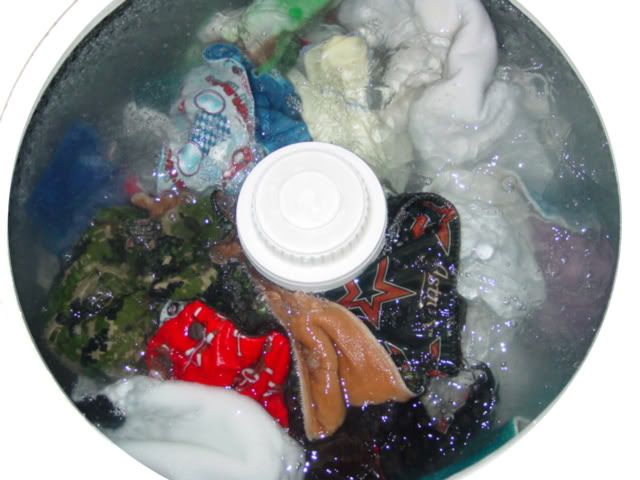
HELLO! That’s because even though the water drains after the rinse, there are still particles left behind on the diapers (this is the same as clothes, towels, etc.) Eventually, what is left behind starts to build up. Build up causes repelling as well as stink!
I decided, after this wash, to do a final rinse in the dishwasher. Sure, coming out of the washer, they looked clean, but I knew better!
FOUR RULES:
- Only use this experiment on diapers that have been washed (no soiled diapers), or diapers that need to be prepped before use.
- Make sure there is no rinse aid in the dishwasher (Jet Dry or something similar).
- Do not use detergent in the dishwasher.
- Turn your heat dry OFF.
 The purpose behind using the dishwasher is to let the jets in the dishwasher actually push the water through the diapers breaking up whatever funk is inside them. The, the water is pushed up to the top and back down the sides of the dishwasher, which leaves less of a chance for left over particles to actually remain on the diapers.
The purpose behind using the dishwasher is to let the jets in the dishwasher actually push the water through the diapers breaking up whatever funk is inside them. The, the water is pushed up to the top and back down the sides of the dishwasher, which leaves less of a chance for left over particles to actually remain on the diapers.
*DISCLAIMER – DO NOT USE YOUR DISHWASHER IF YOU HAVE A RINSE AID IN IT. ALSO, DO NOT USE DETERGENT!
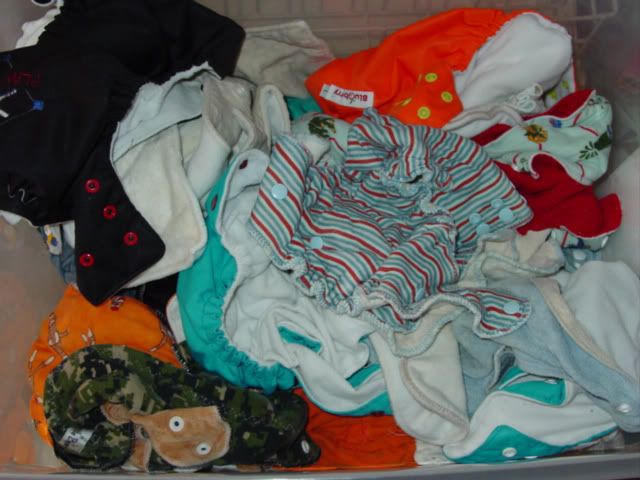
I lined the bottom of the dishwasher with Hawk diapers.. I made sure to fold them with All in One the inners out because that’s where the funk builds up. I also made sure that the tabs were tucked in so that they would not hang down.

I set the dishwasher to the longest, most vigorous setting so that the diapers would be completely rinsed.

Because they are smaller, I lined the top basket with all of the inserts, snap-ins, doublers, and a couple of diapers that that didn’t fit on the bottom rack.
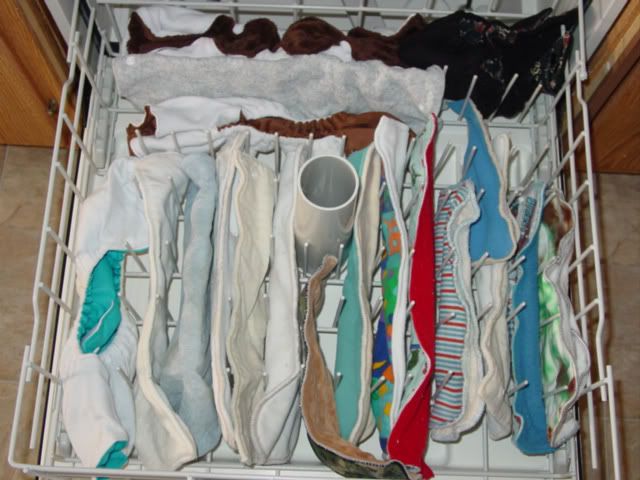
IMPORTANT PHOTO:
TURN OFF YOUR HEAT DRY!
By turning off your heat dry, this keeps your heating element from turning on at the bottom of the dishwasher in the event that some of your diapers hang down.
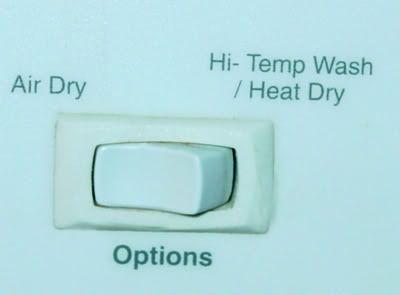
After about 15 minutes in the dishwasher, I opened it, and this is what I saw. There were lots of suds at the bottom of the dishwasher from the left over soap particles that were in the diapers.
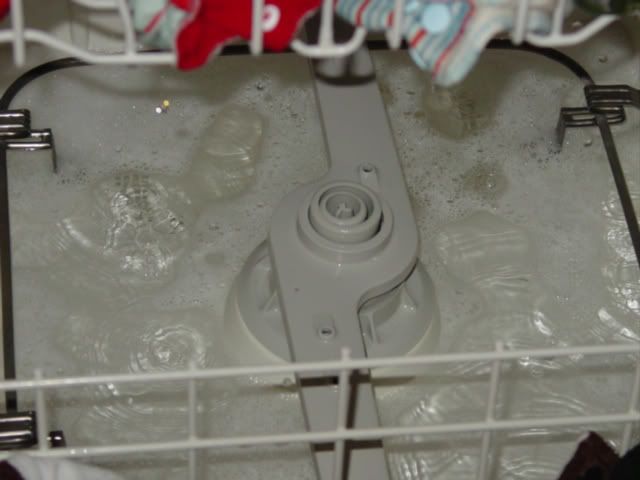
This actual photo experiment was done a couple of years ago, and although I remember running the diapers through the washing machine again just to see if the water was clean, I’m unable to find the photo.
The rinse in the washing machine proved my point. The water was clear after stripping these diapers in the dishwasher. I also found that the “stunk” was gone, and there was no more ammonia build up on the diapers!
If you find yourself in need of a good de-funk, don’t hesitate to use your dishwasher to strip your cloth diapers.
Disclaimer: The dishwasher stripping method is controversial, but if you think about it, what ISN’T controversial when it comes to cloth diaper care? Pick your battles and do what works best for you! You can use this as a last resort if you’d like, but because PUL was invented for medical purposes, it was made with the intentions of needing extremely high heats to sanitize. I’ve never had a problem with this method, although, it’s not something that I do every day! This is a once-every-six-months-to-a-year process and it will probably void your warranty, only because it’s an unorthodox method of stripping —— however, so will bleach, and vinegar, and Dawn dish soap on most major brands!


crud just when I get the stinkis I move and then I dont have a dishwasher anymore 🙁 I need a dishwasher again I hate not having one! This is an awesome idea!
The temperature of the water in the dishwasher is higher than most PUL is warrantied for. I would not put PUL in the dishwasher and risk my diapers being ruined. Typical dishwashers use water from 130-170* F and most diaper companies range their PUL from 110-130.
I only wash my Flip and BumGenius inserts in the dishwasher, nothing with PUL. After several months of struggling with ammonia issues and trying many different ways to strip……Dawn, Rockin Green, Tide, more soap, less soap, extra rinses, etc……I finally tried the dishwasher. I had to do about 3 washes the first time but I am totally amazed at the results. Not one hint of ammonia or stink in any of my inserts anymore. Truely a miracle!! I only have to do it about once every 6 weeks now to maintain.
Omg, ty sooo much for this post. can not wait to try this TODAY! Pumped! Ty again!
You are welcome! Let me know how it goes! 🙂 My washing machine went out, so I’m going to have to handwash today to get all the EWWW off of the diaperrs, and then I’ll strip them in the dishwasher until I can get my new machine! 🙂
Lol prob a really dumb ? But did you dry them before putting them in the d.w.?
Nah! Just one more step you’d have to take!
Thank you! I just tried this yesterday to get the stink out of the little mans diapers. They are drying NOW… so I will let you know if this worked for us 😉
So we tried this tonight and they smell worse! But after reading a previous comment, should I do it a couple more times? The diapers are awful as soon as they get wet they smell like ammonia! PLEASE HELP!
Hi there!
Just wondering if you’ve noticed any issues with the snaps on the diapers – I’m not so much concerned with the PUL being affected by the heat as I am the plastic snaps. Any feedback?
I’ve never had an issue with any of my snaps, however, this isn’t something that I do all the time. It’s only done every so often. I just can’t see it being any different than drying them on hot in the dryer. I know that my dryer gets really, really hot, too, and I’ve never had any snap issues with that either.